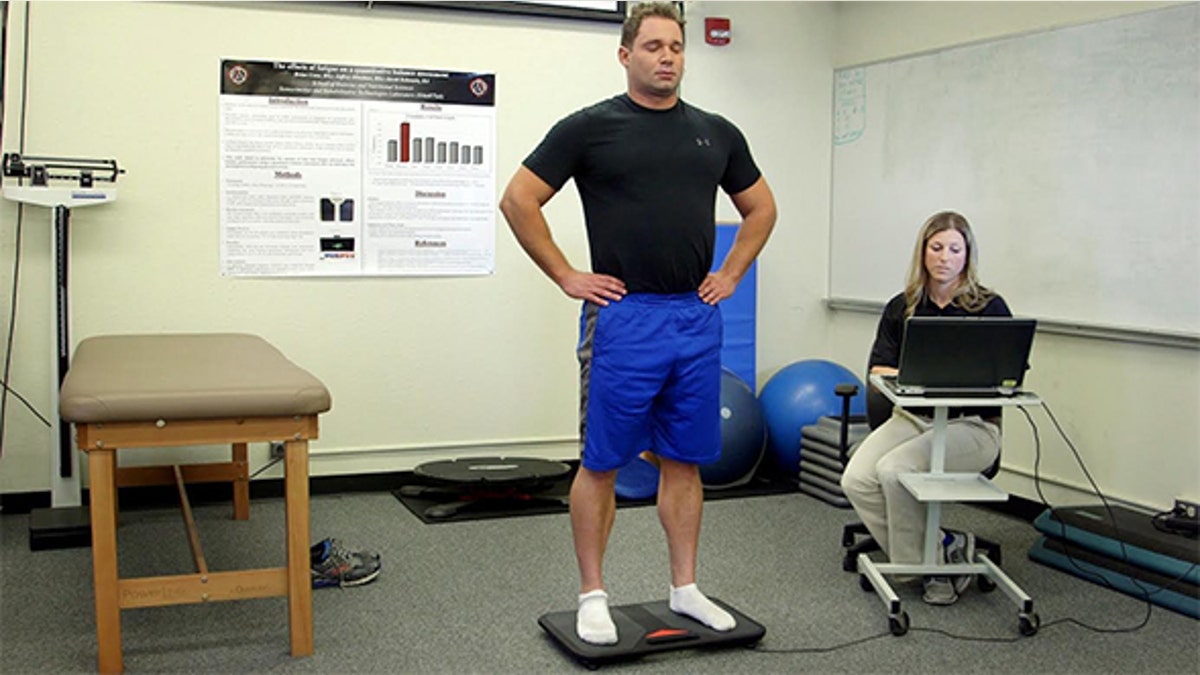
An athlete testing the BTrackS system. (Image courtesy of SDSU.)
After a year of testing on athletes at San Diego State University (SDSU), a new device utilizing balance measurements to help objectively diagnose athletes with concussions has proven effective. Now, it’s just waiting for approval from the U.S. Food and Drug Administration (FDA).
First covered by FoxNews.com last year, the B-TrackS force plate was designed by researchers at SDSU as a cheaper, easier and more accurate way for trainers to identify concussions in athletes.
Currently, there are few ways to objectively determine whether an athlete has experienced a mild traumatic brain injury. After a blow to the head, an athlete will be asked a series of questions by trainers or medical professions to assess any memory loss. They may also be asked to perform a simple balance test – such as standing on one leg – to determine any physical symptoms.
But the inconclusive nature of these tests can make it easy for athletes to fake their way back onto the field or for trainers to miss a potentially damaging head injury.
Seeking a way to improve concussion diagnoses, researchers at SDSU developed a device called the B-TrackS force plate. The inexpensive balancing plate provides a definitive measure any changes in an athlete’s ability to balance after a concussion. Now, after a year of testing the device on student athletes, the plate is on the verge of receiving FDA approval.
Last summer, researchers at SDSU recruited athletes from the rugby team, women’s water polo team and men’s soccer team, among a handful of other student athletes, to test the B-TrackS device. They acquired baseline data on approximately 150 athletes and performed follow-up testing on six to 10 athletes who experienced suspected concussions throughout the year.
“The good news from that is, from a scientific perspective, we were able to see a difference in the individual’s balance following a concussion,” Daniel Goble, inventor of the device and an exercise and nutritional sciences professor at SDSU, told FoxNews.com.
The force plate measures the number of centimeters of sway in an athlete’s stance over the course of a single 20 second trial, while they stand on the B-TrackS force plate. Based on their testing, Goble and his team were able to measure the degree to which an athlete’s balance was affected by a head injury.
“It depends on severity; a more severe concussion will [yield] a greater amount of sway,” Goble said. “We saw numbers five to seven times higher than the base number; those were severe concussions. We also had smaller concussions, and in that case, it wasn’t even doubled, but it was higher.”
Goble said the device has been positively received by athletic trainers and coaches, who have long had to rely only on their professional judgment to diagnose concussions on the sidelines.
“The trainers really like the fact that this is an objective test. They are no longer reliant on their own skills…,” Goble said. “They like that it is lightweight and portable; they can use it all over the place; and it’s nice to have that confidence in the assessment that you’re doing.”
The device is now awaiting approval form the FDA as a class one medical device. After it receives approval, Goble can begin manufacturing and selling the B-TrackS system. And at just $795 each, the device’s price is significantly lower than that of other force plates, which can retail for up to $10,000.
“I don’t know if there’s anything comparable in terms of the combination of accuracy and price,” Goble said. “Either you can get the same accuracy with more expensive force plates that exist. And there are certainly cheaper things that measure balance but don’t have same accuracy. At this moment we’re the only ones who have both of those.”
Overall, Goble hopes the device will help more accurately diagnose concussions – so that athletes can be sidelined until they recover.
“The one thing I think we can really help out with is second impact syndrome…It’s not so much the first concussion that’s the problem, it’s when you get a second concussion before the first is resolved,” Goble said. “If we can get this technology out there and get student athletes tested and not have them go back too quickly and avoid these second impacts, which have serious consequences, that would be amazing.”
For more information, visit BalanceTrackingSystems.com.
